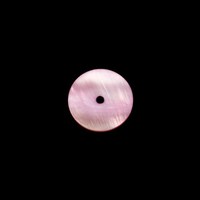Beader’s dictionary
H
HAIR PIN:BOBBY PIN (See products)
Metal accessory used to hold the hair. They may be of many forms and often hold hair by pressure or by means of a closure system. Models ready to be decorated can be found for costume jewelry. These decorations can be attached using various wires or glued directly to its metal structure.
HAMMER
Tool used to hammer and forge metal wires made of aluminum, copper, brass and precious metals. It’s made of a metal head and has a flat face and a round or pointy peen. The surfaces determine the texture and finish of the hammered element. The face of the hammer flat hammers, whereas the round peen textures the metal by making small cavities. The sharp peen allows making grooves in the metal. The wooden handle softens the choc and is built so that the hand is positioned at the exact spot of the center of percussion, which optimizes the hammer’s use. Use it on an anvil or a bunch of steel as a hammering surface.
Hammering metal wires gives them a new look and increases their solidity. The metal transforms itself: it expands, lengthens, hardens and becomes shinier. For more textures, use a texturing hammer.
HAMMERING
Hammering is a technique used in the fashion jewelry making industry. It is used to shape and forge metal using a hammer. The metal can be shaped as a plate or strings. For better results, work on a surface such as an anvil, a steel block or a triblet (ring mandrel). Hammering forges, textures and hardens metal. The end result of the hammering technique will vary according to the part of the hammer (in this case the peen) that is used. The flat surface hammers flat, without texturing, whereas the other extremity can be round, beveled or have various pattern and is used to texture.
Hammering is often done on metal wires such as aluminum, copper and silver. Warning, hammering too strongly can weaken the metal and the colored coating of the wire in some cases.
HEAD PIN
Metal rod also called “nail”, that can vary from 16 to 75 mm in length. It is generally equipped with a small flat head. However, it can also be found with a round or adorned head. The flat headed rod acts as a stopper to stop the beads that are strung on it. Usually, the nail is finished at its other extremity by a handmade loop. A charm is then obtained. They can be made of different metals, such as sterling silver, vermeil, gold-filled and other alloys, in diameters reaching from 0.5 to 0.7 mm.
HEISHI
The term heishi (also heishe) refers to a piece of seashell that is round and flat and that has its center pierced, which gives it a disk-like shape. Although, the term heishi is also used to designate organic handmade beads cut in a similar fashion. The most common heishis are made of seashells, gemstones and wood. When several heishi shaped beads are strung on a same string, they present a tubular aspect.
HEMATITE
The hematite also called sanguine, is an opaque grey-black or black to blood-brown colored stone with a sharp metallic shine. Its name is derived from the greek word haima (blood), because while being cut, it taints water with a red shade. When cut in a thin plate, the hematite is translucent. Its metallic shine appears when it is polished. The main deposits are in England, Bangladesh, Brazil, in China, the United-States of America, In New-Zealand and in the Czech republic.
HORN (See products)
Horns are organic matters that are made of keratin (nails are made of the same matter). Horns can be grated, filed, sawed, cut, welded together, bended and dyed. Horns are naturally translucent, off white, yellow or black.
A little bit of history: bovine and buffalo horns have been used to make combs, barrettes and buttons since the New Art movement (end of the XIXth to XXe century). This material was discovered and used for the first time in the jewelry making industry by René Lalique (1869-1945) who used it to make beautiful decorative combs.
HOWLITE (See products)
Howlite is an opaque white colored stone, at times veined with brown or black. This stone can be easily dyed because of its porosity and its neutral color.
A little bit of history: This stone was discovered in Nova-Scotia in 1868, by canadian chemist Henry How, after whom it was named.















